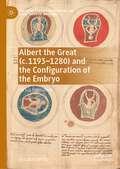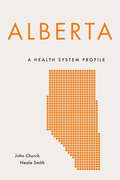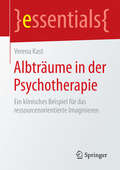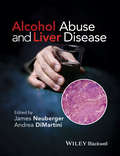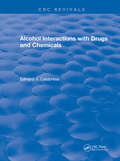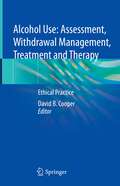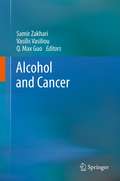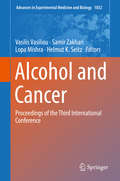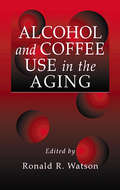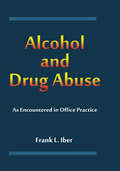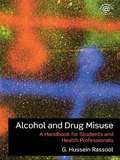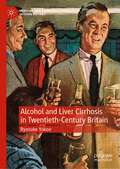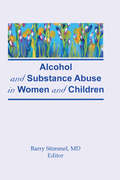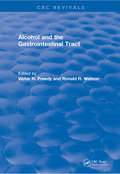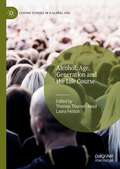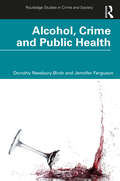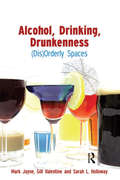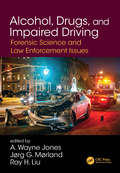- Table View
- List View
Albert the Great: Virtus Formativa (Palgrave Studies in Medieval and Early Modern Medicine)
by Amalia CerritoThis book provides the first comprehensive treatment of Albert the Great’s (c. 1193–1280) notion of virtus formativa, a shaping force responsible for crucial dynamics in the formation of living beings. Crossing the boundaries between theology and philosophy, the notion of virtus formativa, or formative power, was central in explaining genetic inheritance and the configuration of the embryo. By adopting an interdisciplinary approach, this book reconstructs how Albert the Great, motivated by theological open issues, reorganised the natural-philosophical and medical theories on embryonic development, creatively drawing upon Greek, Patristic, and Arabic sources. A valuable contribution to research, this book offers essential insights for those studying the history of embryology, medicine, and science in the medieval and renaissance periods.
Alberta: A Health System Profile (Provincial and Territorial Health System Profiles)
by John Church Neale SmithAlberta: A Health System Profile provides the first detailed description of Alberta’s health care system and the underpinning political and social forces that have shaped it. Drawing on significant wealth from government revenues generated through the energy sector, Alberta has been able to develop an extensive public health and health care infrastructure. Alberta has used its financial resources to attract health professionals by offering the highest levels of financial compensation in Canada. However, although it spends more per capita than other Canadian jurisdictions, Alberta’s health care system costs and health outcomes are mediocre compared to those of many other Canadian jurisdictions. This unexpected outcome is the consequence of the unique interplay of economic and political forces within Alberta’s political economy. Through an examination of Alberta’s political and economic history, and using research on the structures and services provided, Alberta: A Health Systems Profile provides a detailed description of the programs and services that constitute Alberta’s health care system.
Albträume in der Psychotherapie: Ein klinisches Beispiel für das ressourcenorientierte Imaginieren (essentials)
by Verena KastVerena Kast schildert, wie im Rahmen der Psychotherapie Imagination im Zusammenhang mit Albträumen als Emotionsregulierung wirken und kreative Fantasien wecken kann. Das Arbeiten mit der Imagination ist hierbei durchsetzt von therapeutischen Interventionen, mit dem Blick darauf, Imaginationen der Angst in Imaginationen überzuführen, die Zukunft ermöglichen, kreativ und oft mit Ansätzen von Freude verbunden sind. Ein klinisches Beispiel zeigt, wie eine Analytikerin mit den Albträumen der Analysandin auch die kreativen Aspekte der Imagination bearbeitet und so einen Zugang zu ihrer Ressource herstellt.
Alchemy of Herbs: Transform Everyday Ingredients into Foods and Remedies That Heal
by Rosalee de la ForêtDid you know there’s a powerful herbal medicine chest in your kitchen?Imagine being prepared for that next cold, scrape, headache, digestive issue, stressful day, or sleepless night with simple ingredients from your cupboard. Instead of pills, reach for:Cinnamon Tea to soothe your throat . . . Garlic Hummus to support your immune system . . . Ginger Lemon Tea for cold and flu symptoms . . . Cayenne Salve to relieve sore muscles . . . Cardamom Chocolate Mousse Cake for heart health . . . A glass of Spiced Cold Brew Coffee as a powerful antioxidant . . .Alchemy of Herbs will show you how to transform common ingredients into foods and remedies that heal. What were once everyday flavorings will become your personal kitchen apothecary. While using herbs can often seem complicated or costly, this book offers a way to learn that’s as simple and inexpensive as cooking dinner.With the guidance of herbalist Rosalee de la Forêt, you’ll understand how to match the properties of each plant to your own unique needs, for a truly personalized approach to health for you and your family.In addition to offering dozens of inspiring recipes, Rosalee examines the history and modern-day use of 29 popular herbs, supporting their healing properties with both scientific studies and in-depth research into herbal energetics.Grow your knowledge of healing herbs and spices, and start using nature’s pharmacy to feed, heal, and nurture your whole family!
Alcohol Abuse and Liver Disease
by James Neuberger Andrea DimartiniFor people with alcohol excess and liver disease, successful management must be two-fold with management of both their psychological/physical addiction to alcohol and their liver disease. Alcohol Abuse and liver disease, with its joint focus on hepatology and psychiatry, provides both hepatologists and psychiatrists of all levels with a practical, concise and didactic guide to the investigation and clinical management of those with alcohol-related problems. Edited by a practicing hepatologist in the UK and a practising specialist in psychiatry/substance abuse in the US, it covers areas such as: * Risk factors for alcoholic liver disease * Interaction of alcohol with other co-morbidities * Clinical assessment of alcohol intake * Detoxification and management of withdrawal * Psychotherapeutic and pharmaceutical interventions * Treatment of liver disease Key points, management diagrams and high-quality images are all be supported by the very latest in clinical guidelines from the major hepatology and psychiatry societies such as the APA, EPA, AASLD and EASL. With increasing emphasis on multi-disciplinary speciality care in this area, this is the ideal tool to consult in order to provide the best care possible care for what are very challenging patients to manage.
Alcohol Interactions with Drugs and Chemicals (CRC Press Revivals)
by Edward J. CalabreseAlcohol Interactions with Drugs and Chemicals is a concise volume that identifies, documents, and assesses the capacity of alcohol to alter the toxicity of chemical pollutants and drugs in animal models and humans. The book systematically assesses interactions according to general chemical classes of inorganic and organic agents. It also presents an integrative discussion of the significance of these findings to public health.Alcohol Interactions with Drugs and Chemicals will be a valuable reference tool for environmental scientists, toxicologists, epidemiologists, and alcohol researchers studying the interactions of alcohol with drugs and chemical pollutants.
Alcohol Problems in the Community
by Larry HarrisonCommunity surveys reveal that about 6% of the adult male and 1% of the adult female population in England and Wales are drinking at high risk levels. Alcohol Problems in the Community examines the implications of recent community care legislation for government policy on alcohol. The first part of the book begins with a report on recent US research on the role of alcohol in the perpetration of child abuse and recent research on young people's drinking problems. This is followed by a study on the prevalence of drinking problems amongst older people which has been underestimated. In the second half of the book empirical evidence is presented on the particular difficulties faced by ethnic, migrant and homeless groups and this emphasis on the centrality of social disadvantage leads on to a consideration of a specific social work role in the assessment and management of alcohol-related problems. Alcohol Problems in the Community is aimed at social work practitioners and students on prequalifying, qualifying and postqualifying social work courses, and it addresses key social work issues in relation to poverty, homelessness, discrimination and drinking problems.
Alcohol Use: Ethical Practice
by David B. CooperThe book brings together the most up-to-date knowledge and expertise covering the whole topic of alcohol. It presents the practical skills needed to offer ethical intervention and treatment and implement ethical person-centered care. It is a practice-based text that aims to improve ethical relationships, responses, care and practice necessary to be effective in interventions and treatment with those experiencing alcohol use and health problems. The focus is on combining the principles and philosophy of alcohol prevention and intervention, in hospital and community. Each chapter provides self-assessment exercises, reflective practice exercises, key points and a "to learn more" section, and develops a theoretical framework, before broadening to include application in care and practice. This work will appeal to a wide readership, from professionals working within the mental health care and practice environment to mental health students.
Alcohol and Alcohol-related Diseases
by Markus Heilig Sebastian MuellerAlcohol is one of the major risk factors for negative health outcomes worldwide. It accounts for more than 60 alcohol-related diseases, ranging from addiction, through liver cirrhosis, to cancer. Collectively, these conditions account for mortality and morbidity that make alcohol use one of the leading preventable causes of disability adjusted life-years (DALYs) lost globally. In this book, an international faculty covers all aspects of alcohol-related disorders, ranging from addiction/alcohol use disorders (AUD) to alcohol-related diseases of other organs such as liver, heart or cancer. A special focus is to reach out to primary care physicians who are in the front line of this major health problem. The book also provides an update for addiction specialists, as well as specialists in internal medicine, gastroenterology and hepatology. The book is divided into sections that include epidemiology, alcohol use disorders and addiction, alcohol-related liver disease, alcoholic hepatitis, primary care and interdisciplinary approaches and other alcohol-related diseases. Besides current diagnostic measures and treatment strategies, the book deals with the many underlying molecular and genetic mechanisms of alcohol toxicity. Novel insights include prospective data on all-cause mortality and the emerging major role of alcohol-mediated hemolysis and enhanced red blood cell turnover. The book also aims at guiding policy makers to handle the topic of alcohol in our society more responsibly.
Alcohol and Cancer (Advances in Experimental Medicine and Biology #815)
by Samir Zakhari Vasilis Vasiliou Q. Max GuoThe World Health Organization has identified chronic alcohol consumption as one of the top ten risk factors for worldwide burden of disease. The International Agency for Research on Cancer has identified alcohol as carcinogenic to humans, including cancers of the upper aerodigestive tract, colon, liver and breast. Alcohol's actions may be direct e.g. effects on retinoic acid and one-carbon metabolism, or indirect, through metabolites such as acetaldehyde and reactive oxygen species or through various signaling pathways that influence cell cycle and apoptosis that may contribute to carcinogenesis. This report reviews the state of the art in alcohol-related cancer research in ten chapters.
Alcohol and Cancer: Proceedings of the Third International Conference (Advances in Experimental Medicine and Biology #1032)
by Samir Zakhari Vasilis Vasiliou Helmut K. Seitz Lopa MishraFollowing the Third Alcohol and Cancer Conference, this volume compiles the most up-to-date research on the role of alcohol consumption in carcinogenesis, from epidemiology to pathology metabolism and stem cells. More specifically, it delves into the effects of alcohol consumption and thyroid cancer, CD133+ progenitor cells, carcinogenic iron accumulation, developmental morphogens, and cancer-inducing epigenetic changes. Alcohol and Cancer: Proceedings of the Third International Conference is a timely update to Biological Basis of Alcohol-Induced Cancer, which followed the Second Alcohol and Cancer Conference, compiling cutting-edge research from graduate students, young scientists, and researchers. It is ideal for graduate students and researchers in oncology, hepatology, epigenetics, and alcohol consumption.
Alcohol and Coffee Use in the Aging
by Ronald R. WatsonAs we age, our physiology changes. Also, we tend to place less emphasis on proper nutrition. The more elderly we grow, the less resistant we become to major diseases such as cancer and heart disease. This state of affairs renders the elderly more vulnerable to alcohol and other drugs of abuse. Alcohol and tobacco are routinely used together. Chroni
Alcohol and Drug Abuse as Encountered in Office Practice
by Frank L. IberThis book has been written to serve as a manual for physicians practicing in a private office setting to recognize and recommend appropriate treatment for patients believed to be substance abusers. While it is not written for drug abuse specialists, it provides information regarding the diagnosis and treatments a competent, concerned physician can provide without becoming immersed in addiction treatment. Topics discussed include the degree to which a physician should become involved, when it is appropriate to refer, using other professions and volunteer groups, and useful medications. Guidelines for recognizing substance abuse, testing to confirm the abuse, confronting the patient, and motivating the patient into specific treatment are also presented. Tables and illustrations are used to summarize major points, making this an extremely useful reference tool for internists and other non-specialist private practitioners.
Alcohol and Drug Misuse: A Guide for Health and Social Care Professionals
by G. Hussein RassoolWritten by an experienced academic author, lecturer and practitioner, this comprehensive textbook provides an introduction to alcohol and drug misuse. It presents: the context of alcohol and drug misuse, and the nature and theories of addiction, including a historical overview and policy initiatives in contemporary society an overview of the problems associated with psychoactive substances and their impact on groups such as culturally and linguistically diverse communities, young people, women, older people and the homeless an understanding of the generic role responses to substance misuse in a variety of different settings and contexts, including primary care, the community and hospitals a framework for assessment, care planning, harm reduction approaches, dealing with overdose, intoxication and withdrawals, and psychological and pharmacological interventions an accessible and skills-oriented approach to assist students and practitioners in dealing with alcohol and drug misuse. This new edition is fully updated and includes new material on: evidence-based pharmacological interventions; recent global strategies in alcohol and drug; dual diagnosis and women; shisha smoking; and current statistics on prevalence of alcohol and drug misuse Alcohol and Drug Misuse takes into account current policy and practice for substance use and misuse and includes a range of pedagogical features to enhance learning. It is essential reading for nursing, health and social work students taking substance misuse modules, as well as related CPD courses for health and social care professionals.
Alcohol and Drug Misuse: A Guide for Health and Social Care Professionals
by G. Hussein RassoolThis comprehensive textbook provides an accessible and skills-oriented introduction to alcohol and substance misuse for healthcare students and practitioners new to the field.Divided into five parts, this text explores: The context of alcohol and drug misuse and the nature and theories of addiction, including a historical overview and policy initiatives in contemporary society. An overview of psychoactive substances and the problems associated with them. An exploration of the impact of psychoactive substances on groups, such as culturally and linguistically diverse communities, young people, women, older people, and the homeless. An understanding of the generic role responses to substance misuse in a variety of different settings and contexts, including primary care, the community, and hospitals. A framework for assessment, care planning, harm reduction approaches, dealing with overdose, intoxication and withdrawals, and psychological and pharmacological interventions. This new edition is fully updated and includes expanded coverage of performance-enhancing drugs, e-cigarettes, cannabis use, gender disparities in substance use and treatment, public health approaches to substance use, and screening tools for alcohol misuse. Alcohol and Drug Misuse is enhanced with activities and learning outcomes throughout.It is essential reading for nursing, healthcare, and social work students taking substance misuse modules, as well as related post-registration/qualification courses for health and social care professionals.
Alcohol and Drug Misuse: A Handbook for Students and Health Professionals
by G. Hussein RassoolWritten by an experienced author and lecturer, this five part text presents an introduction to drug and alcohol misuse and provides: the context of alcohol and drug misuse, and the nature and theories of addiction, including a historical overview and policy initiatives in contemporary society an overview of the problems associated with psychoactive substances and their impact on groups such as black and minority ethnic people, young people, women, older people and the homeless an understanding of the generic role responses to substance misuse in a variety of different settings and contexts, including primary care, community and hospitals a framework for assessment, care planning, harm reduction approach, dealing with overdose, intoxication and withdrawals, psychological and pharmacological interventions an accessible and skills-oriented approach to assist students and practitioners in dealing with drug and alcohol misuse. Alcohol and Drug Misuse takes into account current policy initiatives and practice for substance use and misuse and includes a range of pedagogical features to enhance learning. It is essential reading for nursing and health students taking substance misuse modules, as well as related CPD courses for health care professionals.
Alcohol and Liver Cirrhosis in Twentieth-Century Britain (Medicine and Biomedical Sciences in Modern History)
by Ryosuke YokoeThe relationship between alcohol consumption and liver cirrhosis has long been contested by doctors and medical professionals, creating numerous implications for the public reputation of alcohol in Britain. Despite this, it was not until the 1970s that cirrhosis came to be understood as an ‘alcoholic disease’. This book contextualises developments in this debate through the twentieth century by examining the significant influence that medical expertise had on policy responses to alcohol misuse, as well as the social reputation of alcohol consumption. It demonstrates how the degree to which drinking was seen to be responsible for liver disease directly shaped how different groups, such as the temperance movement and the drinks industry, exaggerated or downplayed the destructive properties of alcohol. Covering a series of themes including the science of disease causation, the social standing of medical expertise, and alcohol and public health policy, this book argues that in order to properly understand the trajectory of debates around drinking we need to consider the twentieth-century ‘alcohol problem’ as primarily a medical issue. Contrary to the tendency by existing works to disassociate perceptions and responses to alcohol use from the objective knowledge of its effects on the body, this book shows that medical understandings of liver disease influenced how alcohol was conceptualised in relation to its harms. Offering a fresh perspective on the interaction between scientific knowledge and policy during the twentieth century, this book provides insights for those researching the social, political and cultural history of modern Britain, as well as historians of medicine and health.
Alcohol and Substance Abuse in Women and Children
by Barry StimmelHere is a timely volume that examines the problems of substance abuse in women and children, with a particular emphasis on the role played by the family in the development and perpetuation of the problem.
Alcohol and Tobacco: Medical and Sociological Aspects of Use, Abuse and Addiction
by Henriette Walter Otto-Michael Lesch Christian Wetschka Michie N. Hesselbrock Victor Hesselbrock Samuel PomboThis updated and revised second edition of “Alcohol and Tobacco” reflects the new ICD 11 and DSM V classifications and provides comprehensive descriptions of new therapeutic approaches, outlining the different interactions between personality, environment and the effects of the respective substance. In addition to new data on prevention-based therapies, especially for smoking addiction, the book also presents essential psychological and sociological strategies, and medication-based therapies. Particular attention is given to new medications and new compounds for e-cigarettes, while a broad overview of the American and European epidemiology of alcohol and nicotine addictions rounds out the coverage. Given the breadth and depth of its coverage, the book will appeal to a wide readership, from professionals to researchers and students.
Alcohol and the Gastrointestinal Tract (CRC Press Revivals)
by Victor R. PreedyThis book covers all aspects of gastrointestinal tract problems caused by alcohol misuse. Opening chapters discuss epidemiology and the metabolism of alcohol and the liver's role in that process. Alcohol and acetaldehyde dehydrogenases, free radicals, and endocrine changes are discussed in detail. Recent advances in the pathophysiology of alcohol-induced disorders are summarized and many chapters detail techniques such as permeability and protein synthesis. Effects on specific organs, including the salivary glands, stomach, pancreas, and small intestine, are also discussed. All contributors and both editors are internationally recognized experts in their fields.
Alcohol in the Maghreb and the Middle East since the Nineteenth Century: Disputes, Policies and Practices (St Antony's Series)
by Elife Biçer-Deveci Philippe BourmaudThis book explores the significance of alcohol in the Middle East and Maghreb as a powerful catalyst of social and political division. It shows that the solidarities and polarities created by disputes over alcohol are built on arguments far more complex than oppositions on religion or consumption alone. In a region in which alcohol is banned by Islamic rules, yet allows its production and consumption, alcohol has always been contentious. However, this volume examines the different forms of social authority – religious, cultural and political – to offer a new understanding of drinking behaviours in the Middle East and North Africa. It suggests that alcohol, being at the same time an import and product of local industry, epitomises the tensions inherent to the conforming of Islamic societies to global trends, which seek to redefine political communities, social hierarchies and gender roles. The chapters challenge common misconceptions about alcohol in this region, arguing instead that medical discourses on alcohol dependency hide stances on national independence in an imperialist context; that the focus on religion also tends to conceal disputes on alcohol as a social struggle; and that disputes on inebriation are more about masculinity than judging private leisure. In doing so, the volume presents alcohol as a way of grasping the power relations that structure the societies of the Middle East and Maghreb.
Alcohol, Age, Generation and the Life Course (Leisure Studies in a Global Era)
by Thomas Thurnell-Read Laura FentonThis volume explores generational differences in alcohol consumption practices and examines the changing role of alcohol across the life course. It considers generational patterns in where, how and why people buy and consume alcohol and how these may interact with identity and belonging and considers how drinking alcohol in adolescence, adulthood, middle-age or later life takes on different functions, meanings and tensions. Alcohol is shown to play an important role in biographical transitions, such as in the coming of age rituals that mark the passage from adolescences to adulthood, whilst drinking alcohol in adulthood and in later life takes on new meanings, pleasures and risks in light of shifting roles and responsibilities relating to work, leisure and the family. The empirically-informed contributions draw on a range of diverse disciplinary backgrounds and a range of cultural contexts provides a nuanced examination of the role of alcohol at different life course stages and explores both continuity and change between generations.
Alcohol, Crime and Public Health (Routledge Studies in Crime and Society)
by Dorothy Newbury-Birch Jennifer FergusonAlcohol, Crime and Public Health explores the issue of drinking in the criminal justice system, providing an overview of the topic from both a criminal justice and a public health perspective. The majority of prisoners in the UK (70%) have an alcohol use disorder, and evidence tells us that risky drinking is high amongst those in contact with all areas of the criminal justice system. Uniquely, this book brings both a criminal justice and a public health perspective to the topic. The book opens by exploring the levels of crime attributed to alcohol, the policy context of alcohol and crime, and the prevalence of risky alcohol consumption in the criminal justice system. The following chapters examine risky drinking amongst men, women and young people in the criminal justice system. The final chapters look at the efficacy of psychosocial interventions for risky drinking in the criminal justice system, and look forward to how researchers and practitioners can work together to produce research in the criminal justice system. Written in an accessible and concise style, Alcohol, Crime and Public Health will be of great use to students of criminology, criminal justice and public health as well as the wider area of public and social policy in relation to alcohol and crime.
Alcohol, Drinking, Drunkenness: (Dis)Orderly Spaces (Studies In Early Medieval Britain Ser.)
by Gill Valentine Sarah L. Holloway Mark JayneWhile disciplines such as anthropology, sociology, politics, social policy and the health and medical sciences have a tradition of exploring the centrality of alcohol, drinking and drunkenness to people's lives, geographers have only previously addressed these topics as a peripheral concern. Over the past few years, however, this view has begun to change, accelerated by an upsurge in interest in alcohol consumption relating to political and popular debate in countries throughout the world. This book represents the first systematic overview of geographies of alcohol, drinking and drunkenness. It asks what role alcohol, drinking and drunkenness plays in people's lives and how space and place are key constituents of alcohol consumption. It also examines the economic, political, social, cultural and spatial practices and processes that are bound up with alcohol, drinking and drunkenness. Designed as a reference text, each chapter blends theoretical material with empirical case studies in order to analyse drinking in public and private space, in the city and the countryside, as well as focusing on gender, generations, ethnicity and emotional and embodied geographies.
Alcohol, Drugs, and Impaired Driving: Forensic Science and Law Enforcement Issues
by Ray H. Liu A. Wayne Jones Jørg G. MørlandAlcohol, Drugs, and Impaired Driving addresses many theoretical and practical issues related to the role played by alcohol and other psychoactive drugs on driving performance, road-traffic safety, and public health. Several key forensic issues are involved in the enforcement of laws regulating driving under the influence of alcohol and/or other drugs, including analytical toxicology, pharmacology of drug action, as well as the relationships between dose taken, concentration levels in the body, and impairment of performance and behavior. Our knowledge of drunken driving is much more comprehensive than drugged driving, so a large part of this book is devoted to alcohol impairment, as well as impairment caused by use of drugs other than alcohol. For convenience, the book is divided into four main sections. The first section gives some historical background about measuring alcohol in blood and breath as evidence for the prosecution of traffic offenders. The important role of the Breathalyzer instrument in traffic-law enforcement, especially in Australia, Canada, and the USA is presented along with a biographical sketch of its inventor (Professor Robert F. Borkenstein of Indiana University) with focus on the man, his work and his impact. The second section discusses several issues related to forensic blood and breath-alcohol alcohol analysis as evidence for prosecution of traffic offenders. This includes how the results should be interpreted in relation to impairment and an evaluation of common defense challenges. Because most countries have adopted concentration per se laws, the main thrust of the prosecution case is the suspect’s measured blood- or breath-alcohol concentration. This legal framework necessitates that the analytical methods used are "fit for purpose" and are subjected to rigorous quality assurance procedures. The third section gives a broad overview of the current state of knowledge about driving under the influence of non-alcohol drugs in various countries. This includes adoption of zero-tolerance laws, concentration per se statutes, and clinical evidence of driver impairment based on field sobriety tests and drug recognition expert evidence. The fourth section deals with epidemiology, enforcement, and countermeasures aimed at reducing the threat of drunken and drugged driving. All articles have appeared previously in the international journal Forensic Science Review, but all are completely updated with current data, references, and the latest research on developments since the articles were published. This book contains a convenient collection of the best articles covering recommendations for blood and breath testing methods, public policy relating to such methods, and forensic and legal implications of the enforcement of measures to counter driving under the influence.
